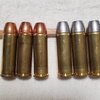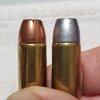Big-bore-bob
Member
Hi all, I'm new to cast bullets and just need some advice on my crimps. I built a load workup with BE86 at 7.0, 7.2, 7.4, with a rimrock 158gr lswc. How do these crimps look?
They look good and heavy to me. Are the bullets firm in the case or can you wiggle or spin them?
 Truly inspiring when he would touch one off! Anyhoo, a little adjustment might help.
Truly inspiring when he would touch one off! Anyhoo, a little adjustment might help.I think you all are referring to the third case in from the left? These cases were previously loaded with h110 and xtp's. I put a heavy crimp on those, some definitely got over crimped on the last loading. I believe you're seeing the imprint of the crimp from the last loading. I was going to trim this off but decided against it since these are range loads. I could definitely lighten the crimp an eighth turn, and seat further out a few thousandths if it will be beneficial. Here's a picture of some sized cases from that same previous batch.a couple of your brass crimps have gone a skosh beyond the crimp die
Yes, I seat and crimp separately.They look fine to me. Do you seat and crimp separately?
They fall in and out of the chamber like factory ammo, no hang ups at all. I'll check the lengths of the cases on the bulk run and set my crimp on the longest case. These cases were trimmed to 1.280 when they were new. They are twice fired. Question: will seating longer a tiny bit more below the driving band give me more tolerance for case length variance? I was wondering if a miniscule gap between the mouth of the case and that top driving band is ok? It looked weird having that gap.sign. The next test is if they chamber and fall out freely.
I can't see the shape of the crimp grove, but if the lower lip is tapered in toward the front driving band then yes. Those tapered groves will also change your oal depending on how much you crimp. I have found that cases trimmed to be uniform in length somehow become unsquare as they are reloaded. As I put them back in the trimmer set to the same 1.280 only part of the case is trimmed... I don't know why it happens but I have observed it happening.Yes, I seat and crimp separately.
They fall in and out of the chamber like factory ammo, no hang ups at all. I'll check the lengths of the cases on the bulk run and set my crimp on the longest case. These cases were trimmed to 1.280 when they were new. They are twice fired. Question: will seating longer a tiny bit more below the driving band give me more tolerance for case length variance? I was wondering if a miniscule gap between the mouth of the case and that top driving band is ok? It looked weird having that gap.
That's an interesting observation, I'll check for that! The coal for these rounds are ending up at 1.572 and rounds are consistent in length across the 30 rounds I loaded. Here's a picture of the bullet I'm loading.I have found that cases trimmed to be uniform in length somehow become unsquare as they are reloaded
That's the taper I was talking about. If you load them long, a strong crimp has the force to draw the bullet down into the case.... freaked me out in 30-30 the first time it happened and I figured it out after a few hours of ponderingThat's an interesting observation, I'll check for that! The coal for these rounds are ending up at 1.572 and rounds are consistent in length across the 30 rounds I loaded. Here's a picture of the bullet I'm loading.
Thanks for the heads up! I'll test these rounds I made up for accuracy and velocity, then I'll readjust my dies to eliminate any of the issues you all have pointed out before loading the 800 pieces of brass I've sized. Thanks for the advice! Always appreciated!That's the taper I was talking about. If you load them long, a strong crimp has the force to draw the bullet down into the case.... freaked me out in 30-30 the first time it happened and I figured it out after a few hours of pondering

Your crimps look good other than a couple, best advice I can give you for 357 is trim your brass even if it is new so they are all the same length. I shoot a lot of 357 use the same bullet you use only I use W296 for powder and Winchester SPM primers . I know there is always a lot of discussion on how heavy to crimp I do a heavy crimp because I have had a bullet back out under recoil and lock up my revolver it is a pain if it happens.Hi all, I'm new to cast bullets and just need some advice on my crimps. I built a load workup with BE86 at 7.0, 7.2, 7.4, with a rimrock 158gr lswc. How do these crimps look?


I've noticed that also.I can't see the shape of the crimp grove, but if the lower lip is tapered in toward the front driving band then yes. Those tapered groves will also change your oal depending on how much you crimp. I have found that cases trimmed to be uniform in length somehow become unsquare as they are reloaded. As I put them back in the trimmer set to the same 1.280 only part of the case is trimmed... I don't know why it happens but I have observed it happening.
best advice I can give you for 357 is trim your brass even if it is new so they are all the same length.
That's the most important thing to me is the trimming. You can't have consistent crimps, consistent OALs, without consistent case lengths. Sooner or later your crimp die will start pulling bullets in on the short cases and buckling the mouth on the longer cases. I set my crimp die to the longest case when setting the dies up,They are inconsistent because brass length varies or seating depth does. As was pointed out a few are curling back out. I love a heavy roll crimp, but trimming to a tight tolerance is needed. One trick is to set the crimp by the longest case.
That's a good sign you did it right.I barely felt any resistance in the press handle crimping them.
Redding makes micro adjustable profile crimp dieI wish someone made a micrometer crimp die for a roll crimp but I don't know if the mic would stay in place when being used. It would sure be convenient though.
